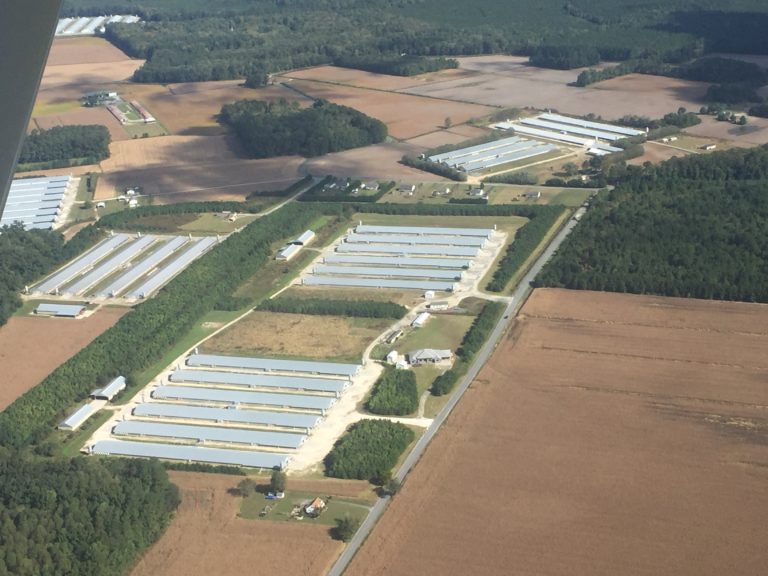Tell EPA to Reestablish CAFOs as a National Enforcement and Compliance Initiative
By: Thomas Hynes

Every four years, the U.S. Environmental Protection Agency (EPA) sets national enforcement and compliance priorities to focus its resources on the nation’s most serious and widespread environmental problems. These priorities, called the National Enforcement and Compliance Initiatives, are intended to “protect human health and the environment by holding polluters accountable and compelling regulated entities to return to compliance.”
EPA is currently accepting public comment on the National Enforcement and Compliance Initiatives to be undertaken by EPA over the coming four-year period of fiscal years 2024–2027. A number of important priorities, including a new initiative addressing PFAS pollution, have been proposed. However, the agency did not include one of the most significant and widespread sources of pollution that is harming environmental justice communities across the country—Concentrated Animal Feeding Operations (CAFOs).
CAFOs produce livestock in geographically concentrated confinement facilities that generate enormous volumes of animal manure and other wastes and employ outdated waste systems that are well documented to create air, water, and land pollution.
EPA has been required to control pollution from CAFOs since the 1970s but has consistently failed to do so resulting in continued industry expansion and widespread non-compliance with the requirements of the Clean Water Act. Decades of well-established scientific research shows that CAFOs routinely discharge water pollution that threatens public health and the environment, including nitrogen, phosphorus, disease-causing pathogens, and pharmaceuticals. Scientific studies, community stories, and a recent report on environmental justice also show that CAFOs harm public health and the environment, especially in communities of color, low-income communities, and under-resourced rural communities nationwide
CAFOs were originally identified as a national strategic enforcement initiative in 1998 when EPA recognized that its “regulatory and voluntary efforts had not been sufficient to address the environmental and health problems” caused by CAFOs. Under that initiative, EPA committed to “take actions against CAFOs that violate current permit requirements and against unpermitted CAFOs that violate existing regulatory requirements” and to “take action in cases where a source of pollution presents an imminent and substantial endangerment to public health or the welfare of the public.”
Due to continued CAFO industry expansion, widespread unaddressed pollution, and high numbers facilities operating without Clean Water Act permits required by law, CAFOs remained as one of EPA’s National Enforcement Initiatives until it was abruptly removed in 2018 through an internal agency memo that provided no justification for the action. Unfortunately, the serious pollution problems from CAFOs that EPA identified in 1998 and the years that followed did not simply disappear in 2018. To the contrary, by many indications, the problems and harms to people and the environment increased dramatically over the years.
For example, in 1998, EPA estimated that there were roughly 6,600 Large CAFOs operating across the United States but only one-third of those operations had obtained the permits required by the Clean Water Act to control their pollution. After that time, water quality monitoring and numerous scientific studies noted the expansion of the industry and the continued environmental and public health harms from CAFOs discharging phosphorus, nitrogen, pathogens, and other pollutants into the nation’s waters. By 2021, EPA reported that there were now 21,237 Large CAFOs operating across the country and 70% of them were operating without the permits required by the Clean Water Act. Unsurprisingly, nutrient pollution from uncontrolled discharges of nitrogen and phosphorus has become a national crisis that is producing toxic algal blooms and impairing drinking water supplies, fisheries, and recreational waters across the country.
That is why we must encourage EPA to protect waterways and communities from the scourge of CAFOs.
EPA identified CAFOs as a national priority in 1998 because of inadequate manure management at CAFOs and the resulting risks, a pattern of CWA noncompliance in the industry, and the need for EPA leadership in implementing the federal CAFO regulations. Those problems have only expanded since that time and now it is irrefutable that the harms associated with widespread, uncontrolled CAFO pollution are disproportionately harming overburdened and vulnerable communities.
Consistent with the current selection criteria, EPA must reestablish the control of surface water and groundwater pollution from animal waste at CAFOs as a National Enforcement and Compliance Initiative for 2024-2027. CAFOs are a major source of ongoing pollution that have been harming environmental justice communities across the country for far too long and the only way to put a stop to this is for EPA to finally start enforcing environmental laws that are essential for protecting human health and the environment.